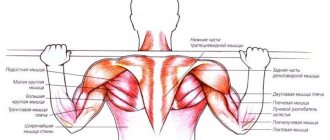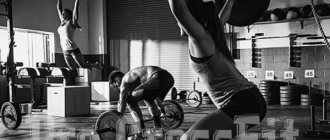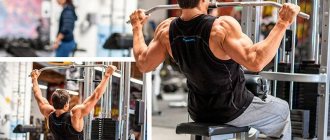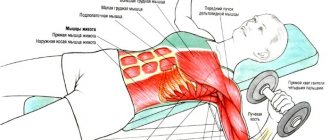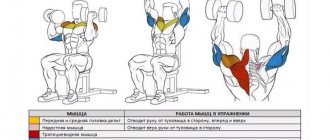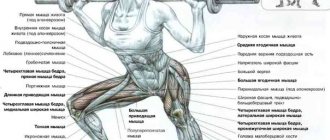Additionally, the rhomboid and trapezius muscles are involved in this exercise. They both bring the shoulder blades together and also contribute to the correct fixation of the shoulder girdle and upper spine.
Swings are isolated exercises, so they are usually performed at the end of a workout in order to “hammer” the muscles well. This exercise is used to train beginners and professionals. The technique is no different, but well-trained athletes can use more weight.
Correct technique
When performing swings, it is important to follow the correct technique. To do this you need:
- Choose dumbbells that have the optimal weight for yourself. They are taken in hands in such a way that the palms face each other.
- Then you need to lean forward so that your torso is parallel to the floor. In this case, it is important to keep your back straight, and your lower back should form a slight deflection.
- In the starting position, the dumbbells are always hung down with straight arms. The arms are well fixed in the elbow joints, which must be slightly bent.
- Before starting the swing, the rear delts are tensed as much as possible, the dumbbells are smoothly raised in different directions, and the lifting is performed smoothly.
- The arms move only vertically, which passes through the shoulders. There is no need to move the weight forward or backward.
- At the top point of the amplitude, the elbows are always higher than the back.
- The weight smoothly lowers to its original position. A short pause is made, and you can begin the next repetition.
Beginners and professionals are recommended to perform 15 to 20 repetitions of swings. It is advisable to do 3-4 sets so that the muscles can work out well. In the future, this will have a positive effect on the results - the deltoids and trapezius muscles will become more elastic and strong.
There are several more options for performing this exercise. Instead of dumbbell swings, you can do crossover flyes .
- To do this, you need to place the bench in the middle of the machine so that your shoulders are in the same plane as the lower blocks. D-shaped handles are attached to the cables of the machine.
- You can start doing the exercise - crossing your arms, doing fly-ups. It is important to do all movements smoothly so as not to harm your joints.
Options and techniques for performing tilted swings
There are several main options for performing tilted swings. They all have their pros and cons. Therefore, only you can decide which option is right for you. You can select several and combine them. Of course, you can develop your own version, but it is unlikely to be as popular as these (although who knows what exactly you will offer)
Bent-over swings
This is a more classic version of the swing. It is performed standing, the weight of the dumbbells is not heavy, since the rear deltoid is a small muscle and can be easily injured. And in general, at first, until they get stronger, it’s better not to take huge weights.
Technique:
- Hold dumbbells in both hands. The grip is neutral, palms facing the direction of the body.
- Feet stand shoulder-width apart, knees slightly bent. Feet parallel to each other. We move the pelvis back and tilt the torso forward. The back is straight, the trapezius is stretched, the shoulders are lowered down. The head is raised, the gaze is directed forward.
- As you exhale, raise your elbows up, spreading them to the sides. In this case, the shoulder blades remain motionless, we work only with the deltoids. We pronate the hands while lifting..
- Hold at the top point for a few seconds, and while inhaling, return your elbows to their original position.
By performing this exercise, you can adjust the angle of your torso. Due to this, the degree of impact on the deltas will change. But at the same time you will have to constantly monitor the stable position of your body. Therefore, at first it will be difficult to concentrate on the work of the rear deltas. This problem can be solved by resting your head on the edge of the bench, as shown in the picture.
Bent over swings while sitting on a bench
This option has a number of differences compared to the previous one. Firstly, a new support point for the pelvis appears, and the legs are turned off from work. This position is much more stable, so you don’t need to concentrate on the balance of your body. But there are still negative sides. Since your knees are in front, it will be impossible to achieve a completely horizontal 90° tilt. And because of this, it will be more difficult to stretch the trapezoid and completely exclude it from work. And of course, the range of movement decreases, since the legs will get in the way. Even with so many disadvantages, the exercise perfectly works the rear deltoids. Especially suitable for beginner athletes and for people who find it difficult to keep their back straight.
Technique:
- Hold dumbbells in both hands with a neutral grip and sit on the edge of a bench.
- Place your legs as far forward as possible, knees together, feet pressed against each other. Bend your torso forward until your chest touches your legs (as if lying on them). There is a slight deflection in the lower back, keep your back straight. The head is raised and the gaze is directed forward.
- As you exhale, spread your elbows to the sides and lift them up. Don't forget to unfold your brushes.
- While inhaling, we return to the starting position.
As far as you noticed, the meaning of the exercise remained the same. Only the starting position has changed.
Swing alternately with one arm while standing
But this exercise can be considered the best in a series of bent over swings (of course, this is purely my personal opinion). It has a number of differences that will have a positive effect on training your deltoids. These are moments such as a large amplitude of movement. Since you are doing the exercise with one hand, the other will not interfere with it and you can safely step into its territory. Plus, this is your stability. After all, in this exercise you will have three points of support, two legs and an arm. Therefore, you don’t have to worry about balance and focus on execution technique. And of course, it will be easier for you to concentrate on the target muscle. After all, attention will be focused on the work of one delta, and not on two. But of course there is one small drawback, this is a double waste of time to complete. Although if there is a lot of it, then this is not a hindrance for you.
Technique:
- Take a dumbbell in one of your hands. Place the other one against some surface (for example, the edge of a bench). The legs stand on the same line, shoulder-width apart, slightly bent at the knees.
- We keep our back straight, our pelvis is pulled back a little, and there is a slight deflection in the lower back. The gaze is directed forward.
- As you exhale, move your elbow to the side and up. While unfolding the brush
- As you inhale, return your arm to its original position, stretching the rear deltoid as follows.
- We change hands and do the same.
This option is best combined with the first two to avoid disproportion of the left or right delta.
Dumbbell swings lying on a bench
But this option has become very popular in recent years. It is performed lying on a bench set at an angle of 45° or slightly less. This option is as isolated as possible, since the legs and back are excluded from the work. Therefore, only one shoulder joint works. Of course, this is great news for us. We can also work in full amplitude, since our legs at the lowest point do not interfere with us. And most importantly, you can choose any angle of inclination and find the one where you feel your deltoids the most. Of course there are disadvantages, but they are not that great. Firstly, due to your chest resting on the bench, there will be slight discomfort at first. This is of course not so critical, but still the feeling is not pleasant. And secondly, because of the same emphasis on the chest, it will be difficult to stretch the trapezoid properly. Therefore, it cannot be completely eliminated.
Technique:
- Set the bench at a 45° angle (or whatever angle you choose). Take dumbbells in your hands and lie on your stomach with your chest on the bench and your toes on the floor. Lower your shoulders as far as possible. The chin is behind the edge of the bench.
- As you inhale, spread your elbows to the sides, lifting them up.
- As you exhale, we return to the starting position.
Everything is clear here. The technique is similar and I don’t think it’s worth going into details.
Safety
It is very important to choose the right weight for this exercise. Dumbbells that are too heavy can cause your body to sway. This should not be allowed under any circumstances, as it can damage the shoulder joints or back. It is better to take a light weight, but do more repetitions, than vice versa.
also important to keep your back perfectly level and parallel to the floor. This position minimizes the load on the spine, which affects the quality of the exercise. The athlete may feel that when the back rounds, the lower back and back begin to hurt a lot. As soon as he straightens his stance, the entire load will go to the deltoids.
Basic technique for performing the “Fly” exercise with one hand
The basic principle of performing the exercise is the same as in the previous case, but there are a number of small differences and features that should be taken into account when performing dumbbell raises while standing with one hand.
Correct execution technique is the key to success
- When performing a dumbbell lift with one hand, the other hand should hold onto a stationary support, such as a squat rack.
- We take a dumbbell in one hand and hold the counter with the other. Feet together, toes and heels should touch. You should be no more than 30 centimeters away from the counter you are holding onto.
- The hand with the dumbbells is located along the body, the shoulders are freely straightened. The inner surface of the hand should be slightly turned towards the body. The body should be slightly tilted towards the hand with the dumbbell.
- We hold on to the counter and straighten our arm, as a result of which the body tilts to the side, which contributes to a greater concentration of the main load on the middle deltoid muscle.
- The hand with the dumbbell rises without a jerk to a parallel position with the floor. Holds for 2 seconds and smoothly returns to the starting position.
- The first approach should be a warm-up with a minimum weight of 10-15 repetitions. The number of approaches and repetitions will depend on the specific training program chosen. If you are a beginner athlete, then it is advisable to draw up a training program with a coach or an experienced specialist.
Common mistakes
One of the most common mistakes is using too much weight. When weakened shoulders try to support this weight, they forcefully round the back, which often leads to injury. To prevent this from happening, you need to take not very heavy dumbbells. To better practice the technique, you should stand sideways to the mirror. This is the only way to see and remove the formed deflection in the back.
When performing swings, you do not need to help yourself with your body . At this moment, the back takes part of the load, so the deltoids are less loaded, and the athlete will not be able to achieve the desired success.
Some beginners try to do this exercise with their arms fully extended . This method of swinging can damage the elbow joints, so they need to be kept in a slightly bent position.
Execution technique
Initial position:
- Spread your legs slightly and bend your knees slightly.
- Bend your torso forward slightly above the horizontal, bend your lower back, and keep your back straight.
- Hold dumbbells in slightly bent arms at the elbow joint opposite the shoulder. Grip straight or parallel.
- Shoulders are relaxed and down.
- Head up, look forward.
Movement:
- As you inhale, without bending your arms any further, raise your arms almost to a straight line with your shoulders.
- As you exhale, lower your arms to the starting position.
- Repeat the planned number of times.
Attention!
Recommendations!
Execution options!
Equipment
Swings are performed with dumbbells, so you need to select your weight in advance. You can start working your muscles with dumbbells that weigh only 5 kg. Next, it should be increased so that the muscles do not get used to the constant load.
When lifting heavy weights, weightlifters often use athletic belts . They keep the lower back muscles in a stable position, allowing you to focus on the upper back. You can also use elastic bandages for your elbows if you have previously had an injury to this joint.
Option 1: standing dumbbell fly technique
This option is the most difficult , since it does not have additional support, so the exercise should be performed with prepared back and abdominal muscles.
- Place your feet shoulder-width apart, bend your knees slightly, and lean forward until your back is parallel to the floor.
- Keep your back straight at all times, as rounding the spine while lifting weights can cause serious injuries to the lumbar region.
- With your arms freely lowered with the dumbbells, bend your elbows slightly, turning them to the sides.
- Exhale: swing the dumbbells out to the sides, raising your arms to the level of your shoulder joints, elbows facing the ceiling. Don't help your arms by jerking or rocking your back. It is important to make the swing faster at the top, but isolate the rear deltoid from the accessory movements.
- Inhale: in the lower phase, make a slower movement - smoothly lower your arms down.
- When gaining muscle mass, it is recommended to perform from 8 to 12 repetitions of 4 sets.
Useful tips
There are many variations of swing execution. They can be done with one or two hands. In this case, you can sit on a bench or do them standing, but in all cases the body should be parallel to the floor. If it is located at a slight angle, then a significant part of the load will go from the deltas to the chest and arms.
It is important to keep your elbows slightly bent . In an ideal position, they always look up, not back. This allows you to use the back of the delta as efficiently as possible, but you need to understand that the quality of the swing depends on the flexibility of the shoulder joint. If he doesn't move well, then the best solution to the problem is to choose a different exercise or regularly do stretching exercises.
When making swing movements, it is advisable to leave your back and shoulder blades in a stationary position . To do this, raise your arms to shoulder level. If they rise to a greater height, the shoulder blades will begin to contract. It is also important not to slouch your shoulders or sway.
There are many recipes for protein shakes, the best of which you can see on our website.
Creatine: how to take, why, what for and much more you will find here: /nutrition/dobavki-nutrition/kak-prinimat-kreatin.html.
The back is much better kept in a straight position if the knees are slightly bent . At the same moment, you need to set an initial inclination for yourself, which you will maintain throughout the entire exercise. For greater comfort, you can rest your forehead on the soft back of the exercise machine.
Analysis of the exercise
Anatomy of exercise - which muscles work
Bent-over dumbbell swings are an isolating exercise that specifically affects the back head of the deltoids, allowing you to give the shoulder a “spherical” shape and “emphasize” the relief.
In addition to the main dorsal segment of the shoulders, the following muscle groups are involved in the movement:
Preparing for the exercise
The technical quality of performing bent-over dumbbell lateral raises largely depends on the mobility of the shoulder joints, so before performing the main approaches, the exercises must be well developed. To do this, perform a gymnastic complex, including rotations and swinging movements with your arms, and additionally stretch your rear deltoid.
Proper execution
- During all phases of movement, the arms should remain bent at a slight angle at the elbow joint. However, keep in mind: the greater the bend angle, the shorter the amplitude of movement, and, accordingly, the lower the efficiency of working out the deltas. But it is not recommended to keep your arms completely straight - this puts stress on the elbow joints.
- Directly abducting the dumbbells to the sides is done while inhaling, the end of the movement is accompanied by exhalation.
- At the moment of raising the arms, the elbow joint should be directed upward, not backward.
- When performing swings, the back is in a straight position with a natural deflection in the lumbar region and a fixed forward tilt angle. Athletes with insufficiently elastic hamstrings will find it easier to maintain a proper S-curve by bending their knees.
- Movement of the arms occurs strictly in a vertical plane relative to the shoulders. Shifting the arms with the implements back transforms the exercise into a kind of “back” row. Bringing them forward makes it difficult to maintain the spine.
- Before lowering the dumbbells to the starting position, pause briefly at the top position to further statically tighten the deltoid.
Errors
Performance Recommendations
Inclusion in the program
Bent-over dumbbell flyes, like any isolation movement, are performed after basic shoulder exercises - in this case, these will be variations of presses and heavy deadlifts. The best physical “response” comes from training them in parallel with the back.
The recommended number of approaches is 3-4, with a standard volume of 12-15 repetitions. When working on hypertrophy, you can also practice “pump” work in a repeated row from 15 to 20 times.
At the same time, you should not overestimate your capabilities when using heavy dumbbells - work with such weights that allow you to feel the work of the deltoids as much as possible. It is better for a beginner to start with equipment weighing 2-3 kg - in light of the fact that the majority of athletes have a dorsal bundle that is “lagging behind”, such a load will be quite noticeable. Having developed a dynamic stereotype, you risk complicating your task by increasing the weight.
Strength mode in deltoid training is used extremely rarely and only by professional athletes.
Contraindications
Lateral raises of dumbbells - basic mistakes
It's not just newbies who make mistakes. Professionals can also make mistakes. But, not from ignorance, but because for a split second they lost control. Unfortunately, this happens.
Standard errors:
- The desire to gain relief as quickly as possible. This leads to the athlete taking on weight that is too heavy for himself. As a result, the exercise is not performed correctly. This leads to severe injury to the muscles of the shoulder girdle.
- Extra movements. Sometimes beginners reflexively make unnecessary movements: they roll from heel to toe or change the position of their legs. You can’t do this, it can also lead to injury. The body must be static.
- Incorrect trajectory of performing dumbbell lateral raises while standing. Throwing a projectile towards the head is a direct path to injury and inflammation of the ligaments.
- Error in setting the home position. Sometimes beginners are faced with such a problem as positioning the body, namely the back, with a tilt back. Under no circumstances should you do this! This is dangerous not only for the muscles of the shoulder girdle, but also for the spine. For this reason, we urge beginners to contact professional trainers who will help you set up the exercise technique correctly.
- Uneven lifting of dumbbells on the left and right. This happens if the spine is curved. In this situation, we recommend consulting a doctor, wearing a special corset, and performing the exercise with only one arm at a time.
- Incorrect pelvic position. Beginners also suffer from this: they slightly bend the hip joint. This results in the load being distributed incorrectly.
- Hip flexion due to fatigue. If you feel too tired, it is better to stop doing the exercise altogether rather than putting weight on the hip joint, thereby making the task easier for yourself.
- Involvement of other muscles in work. This also happens because the athlete is tired. Tired? Rest. To practice reflex muscle isolation, contact a trainer. This will help you get a better feel for the area you are working on.
As you can see, there are a lot of errors. To hone a technique to perfection, you need patience and desire. It is important to be aware that any incorrect movement can lead to injury!
Features of the exercise
Raising arms with dumbbells while standing to the sides is an exercise that has its own characteristics. Taking these features into account and following the rules will help you achieve the necessary relief while maintaining healthy joints.
Peculiarities:
- Wiring is performed only with the weight that is right for you. How do you know what weight you need? Go to the trainer. There is no need to select the weight at random. Most beginners start working with this exercise with 2-3 kilograms.
- If you take too little weight, nothing will change. If you take too much weight, the load will most likely transfer to the elbow joint. In this situation, the execution technique suffers greatly. Too much weight will result in injury.
- If you raise your arms too high, the trapezius muscles will be involved in the work. Did you have plans to train this muscle group? Fine. If not, then make sure that your arms with dumbbells are raised parallel to the floor.
- You need to raise your arms while exhaling. We return to the starting position while inhaling.
- When performing the last repetition, hold your arms parallel to the floor for 10-15 seconds. This will help strengthen your muscles. and consolidate the effect of the training.
- You need to lower your arms smoothly, without sudden movements or aggressive throws.
To perform the exercise correctly, knowledge and skill are required. At first, contact your coach for help. This way you will learn more nuances about performing the exercise and protect your ligaments and joints from injury. In addition, remember that good results cannot be achieved if you do not monitor your diet.
Share link:
Rate this article

